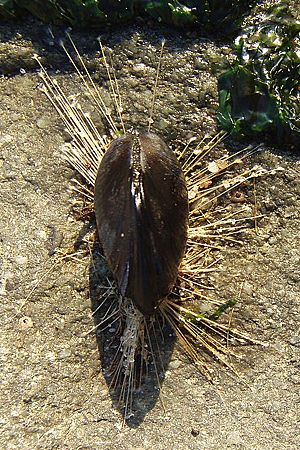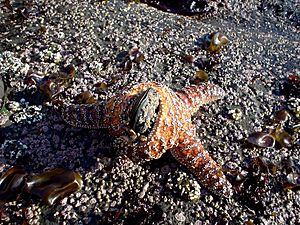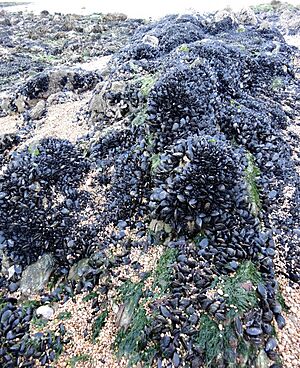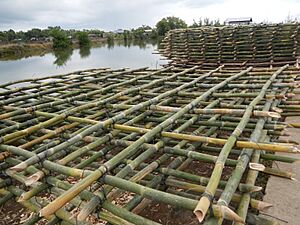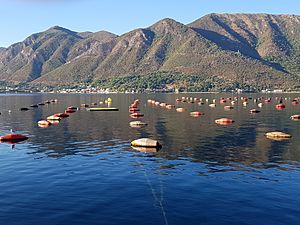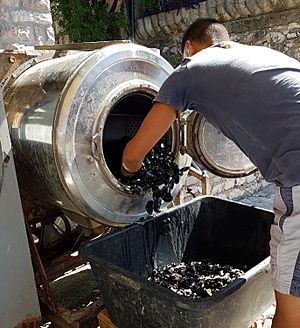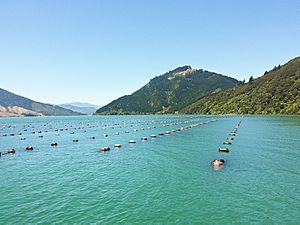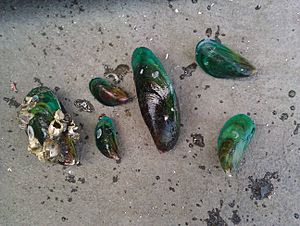Mussel facts for kids
Quick facts for kids Mussel |
|
|---|---|
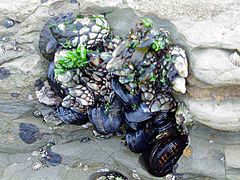 |
|
| Mussels | |
| Scientific classification | |
| Kingdom: | |
| Phylum: | |
| Class: | |
| Subclasses | |
|
Pteriomorpha (marine mussels) |
|
Mussels are a type of mollusc with two hinged shells. They live in many places around the world. You can find them in lakes, rivers, and creeks. Some also live along ocean coastlines in areas that are covered and uncovered by tides.
Even though they look alike, freshwater mussels and saltwater mussels are not closely related. They belong to different groups. For example, Zebra mussels are freshwater mussels that attach to rocks. But they are grouped with "clams," not marine mussels.
People have eaten mussels for thousands of years. You can cook them or eat them raw. But be careful! Mussels can become unsafe to eat very quickly after they die.
Contents
Mussel Body Parts
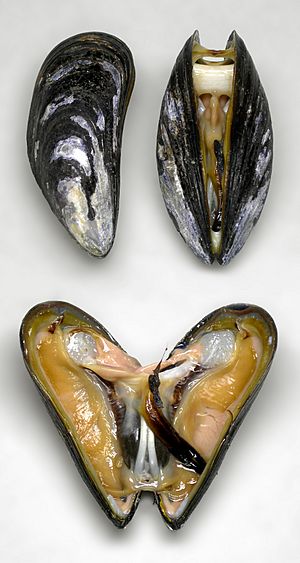
A mussel's outer shell has two halves, called "valves." These halves are joined by a stretchy band on the outside. Strong muscles inside the mussel close the shell when needed. The shell helps protect the soft body inside. It also keeps the mussel from drying out.
The shell has three layers. Like most bivalves, mussels have a large organ called a foot. In freshwater mussels, the foot is big and strong. It helps the mussel move through sand or mud. It does this by pushing the foot forward, making it wider to anchor, then pulling the rest of the body.
Marine mussels have a smaller, tongue-shaped foot. This foot has a special groove. This groove helps create strong threads called byssal threads. These threads help the mussel stick to rocks.
Mussels sometimes use byssal threads to protect themselves. They can tie up predators like dog whelks. This stops the predators from moving and can starve them. When cooking mussels, these byssal threads are called the "beard" and are removed.
How Mussels Live
Feeding
Both marine and freshwater mussels are filter feeders. This means they eat tiny bits of food floating in the water. They filter out plankton and other small creatures.
Marine mussels often live in groups on rocks that waves hit. They use their byssus to attach firmly to the rock. Living in clumps helps them stay strong against waves. It also helps mussels in the middle of a group stay wet at low tide.
Reproduction
Most mussels have separate male and female individuals. In marine mussels, males release sperm and females release eggs into the water. The eggs are fertilized outside the body. A tiny larva then floats for weeks or months. After this, it settles on a hard surface and grows into a young mussel. It can move slowly by attaching and detaching its byssal threads.
Freshwater mussels reproduce differently. Males release sperm into the water. The sperm enters the female's body. After fertilization, the eggs become tiny larvae called glochidia. These glochidia temporarily attach to fish, usually on their fins or gills. They stay there for a few weeks.
Glochidia usually need a specific type of fish to survive. Once attached, the fish's body covers them with a small cyst. Inside this cyst, the glochidia grow. Then they break free from the fish and drop to the bottom. There, they begin to live on their own.
Predators
Many animals eat mussels. Humans, starfish, and seabirds eat marine mussels. Some sea snails also hunt them. Freshwater mussels are eaten by otters, raccoons, ducks, and geese.
Where Mussels Live
Marine mussels are very common in the middle and lower parts of the intertidal zone. This is the area of the coast that is covered and uncovered by tides. They are found all over the world in temperate (mild climate) seas. Some marine mussels also live in tropical areas.
Some marine mussels like calm bays or salt marshes. Others prefer areas with strong waves. Some even live deep in the ocean near hot hydrothermal vents. One type of mussel in South Africa burrows into sandy beaches instead of sticking to rocks.
Freshwater mussels live in lakes, rivers, and streams worldwide. They need cool, clean water. They also prefer water with minerals, like calcium carbonate, to build their shells.
Mussel Farming
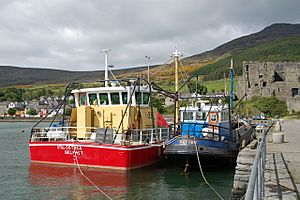
Mussel farming, also called aquaculture, is a big business. In 2005, China produced 40% of the world's farmed mussels. In Europe, Spain has been a leader in mussel farming for centuries. In North America, mussel farming started in the 1970s. Most farmed mussels in North America come from Prince Edward Island in Canada.
How Mussels are Farmed
Some marine mussels are farmed for food. These include the Blue mussel and the New Zealand green-lipped mussel. Farmers often collect young mussels (called "seed") from the wild. Or they buy seed grown in special hatcheries.
The young mussels are then moved to growing areas. They are often placed in mesh tubes called "socks." These socks are hung from long ropes or rafts in the water. Within a few days, the mussels move to the outside of the sock to get more food. Mussels grow fast and are usually ready to harvest in less than two years.
Mussels can be grown in different ways:
- Bouchot culture: Mussels grow on ropes tied around wooden poles planted in the sea.
- On-bottom culture: Young mussels are moved to areas where they can grow faster and be protected from predators.
- Raft culture: Ropes with young mussels are hung straight down from rafts floating on the water.
- Longline culture: Mussels are attached to ropes that hang from a long rope supported by floats. This method is common in New Zealand.
Harvesting Mussels
Mussels are ready to harvest in about 12 to 15 months. How they are harvested depends on how they were grown. For mussels grown on the seabed, special dredges are used. Mussels on wooden poles can be picked by hand or with machines. For raft and longline culture, platforms are used to lift the mussel lines out of the water. After harvest, mussels are often put in clean seawater tanks to remove any dirt before they are sold.
Mussels in Medicine
The byssal threads that mussels use to stick to things are very strong. Scientists are studying these "mussel glues" for use in industry and even in surgery. These threads have also given ideas for making artificial body parts, like tendons.
Mussels and the Environment
Mussels are often used as "bio-indicators." This means they help scientists check how healthy water environments are. They can show if there is pollution in rivers or oceans.
Mussel Conservation
Freshwater Mussels
The United States and Canada have the most types of freshwater mussels in the world. But many of these species are in danger. About 70% of freshwater mussel types are listed as endangered or threatened. This is mainly because of dams, too much mud in the water, changes to river channels, and new species like the Zebra mussel that take over their homes.
Mussels as Food
People have eaten mussels for thousands of years. About 17 types of mussels are safe to eat. The most common ones are the Blue mussel and the New Zealand green-lipped mussel.
Freshwater mussels are usually not eaten because they don't taste good. However, some native peoples still eat them. During World War II, mussels became a popular food in the USA. This was because other meats like beef and pork were rationed and sent to soldiers.
In Belgium, the Netherlands, and France, mussels are often eaten with French fries (called "moules-frites"). They might be cooked with herbs and vegetables in white wine. In France, there's a special mussel bake called "Éclade des Moules" cooked on beaches.
In Italy and Spain, mussels are often steamed with white wine and herbs. In Spain, they can also be made into "tigres," which are fried croquettes in the mussel shell. In Turkey, mussels are fried on sticks or stuffed with rice. In New Zealand, they are used in fritters or chowder. In India, mussels are popular in coastal areas and cooked with vegetables or stuffed with rice and spices.
How to Prepare Mussels
Mussels can be smoked, boiled, steamed, roasted, or fried. It's very important to check that mussels are alive just before you cook them. If they are dead, they can quickly become unsafe to eat. A live mussel will close its shell tightly when you tap it. If a mussel is open and doesn't close, it's dead and should be thrown away.
Before cooking, rinse mussels well and remove the "beard" (byssal threads). Mussels usually open their shells when they are cooked.
Sometimes, mussels can contain toxins from tiny organisms they eat. This can make them poisonous if not handled correctly.


